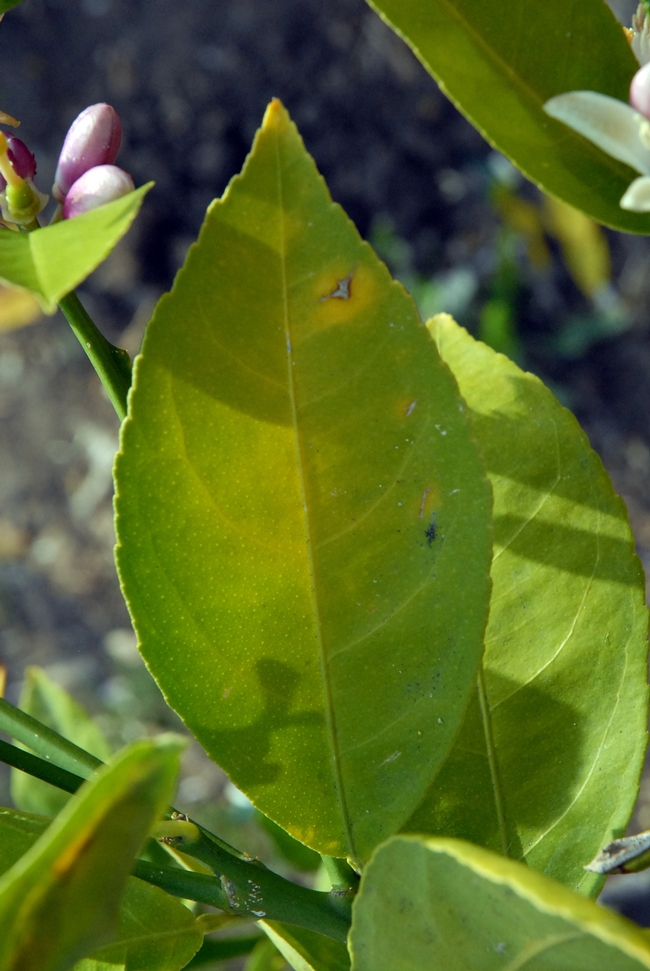Posts Tagged: Wenbo Ma
UC ANR scientists urge citrus farmers and backyard growers to be vigilant in face of new disease find
Now that two additional backyard citrus trees in Southern California were found to be infected with the bacterium that causes Huanglongbing (HLB) disease, UC Agriculture and Natural Resources (UC ANR) Cooperative Extension advisors and specialists are encouraging all citrus owners to monitor for disease symptoms and report trees suspected to be infected with HLB to the California Department of Food and Agriculture (CDFA) hotline, (800) 491-1899.
This month, a lime tree and a kumquat tree with HLB were identified in residential areas of the San Gabriel Valley. In March 2012, an infected multi-grafted citrus was found in a Hacienda Heights backyard.
“So far, the bacterium that causes HLB has been found infecting only three trees, which have all been destroyed,” said Beth Grafton-Cardwell, UC ANR Cooperative Extension citrus entomology specialist. “However, it is highly likely there are other infected trees in California. It will be critical for all Californians to assist with efforts to reduce psyllids and detect and remove infected trees to prevent this disease from devastating California citrus.”
An early symptom of Huanglongbing disease is yellowing of leaves on an individual limb or one sector of the tree's canopy, according to a UC ANR Integrated Pest Management Program Pest Note. Leaves that turn yellow from HLB will show an asymmetrical pattern of blotchy yellowing or mottling of the leaves. The Pest Note includes color pictures and detailed symptom descriptions.
HLB disease is spread from tree to tree by Asian citrus psyllid, an invasive insect first identified in California in 2008. ACP has become established in many Southern California communities and is seen occasionally in the state's San Joaquin Valley and Central Coast commercial citrus production areas. Locations where ACP are found are quarantined by CDFA. No untreated or unprocessed citrus fruit and no citrus trees may be moved from these areas. UC ANR maintains an online map that delineates the quarantined locations. The map also shows the area quarantined because of the recent HLB find.
Once a tree is infected with the bacterium that causes HLB, there is no cure. To prevent HLB infections, citrus owners in areas where Asian citrus psyllids are found may wish to treat their trees with insecticides.
“We believe about 60 percent of Californians have at least one citrus tree in their yard, so HLB could have a devastating effect on the California residential landscape,” Grafton-Cardwell said. “There are safe and effective ways to reduce the ACP population, which reduces the chances of losing a tree to HLB.”
Grafton-Cardwell developed a website for farmers and residents with detailed information on managing Asian citrus psyllid. In some urban areas, a natural enemy of ACP, Tamarixia radiata, has been released. In those areas, Grafton-Cardwell recommends the use of “soft” insecticides that will reduce the number of psyllids and allow the Tamarixia to control the rest.
If Tamarixia are not in the area, the website gives information on broad spectrum insecticides to reduce the number of psyllids. The website provides the names of the pesticides, their costs, the duration of control and the effectiveness of the pesticides against ACP.
To help California residents and commercial citrus growers deal with the ACP and HLB citrus threats, UC ANR, UC Davis and UC Riverside scientists are conducting research on a number of possible solutions.
For example, Abhaya Dandekar, professor in the Department of Plant Sciences at UC Davis, and his colleagues are studying gene fusion, which fuses two immunosuppressive genes that attack HLB in different ways to make the plant more effective at fighting the disease.
Mikeal Roose, a professor in the Department of Botany and Plant Sciences at UC Riverside, is working with researchers in Florida to sequence a rootstock that has some natural resistance to HLB and locate the gene or genes that cause HLB resistance.
Mark Hoddle, UC ANR Cooperative Extension biocontrol specialist at UC Riverside, has identified a second natural enemy of ACP from the Punjab, Pakistan. (The first one was Tamarixia radiata.) Populations of Diaphorencyrtus aligarhensis have also been released in urban areas and Hoddle is monitoring the insect's ability to attack ACP.
Because it is important to remove trees infected with HLB as soon as possible to reduce spread, UC scientists are also studying ways to identify trees with the disease before visual symptoms occur.
For example, Hailing Jin, professor in the Department of Plant Pathology at UC Riverside, has identified small RNAs that are induced by the bacterium that causes HLB and could be used for early diagnosis.
Carolyn Slupsky, professor in the Department of Food Science and Technology at UC Davis, has identified metabolites that change in concentration when citrus is infected with the bacterium that causes HLB. She is working with the Citrus Research Board (CRB), CDFA, Texas A&M, and USDA to validate her results and determine how quickly the disease may be detected once the tree has been exposed to the pathogen. She is also part of a USDA collaborative grant to study the vector that transmits the disease to help find ways to stop transmission.
Wenbo Ma, professor in the Department of Plant Pathology Microbiology at UC Riverside, has developed antibodies against proteins secreted by the HLB pathogen – revealing whether the plant is infected. These antibodies have been evaluated in California, Florida and Texas for HLB detection.
An initiative to manage endemic and invasive pests and diseases is part of UC Agriculture and Natural Resources Strategic Vision 2025.
This story is also available in Spanish.
Author: Jeannette Warnert



